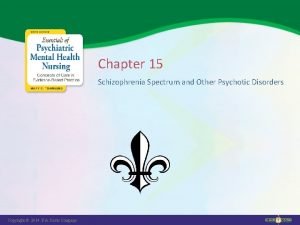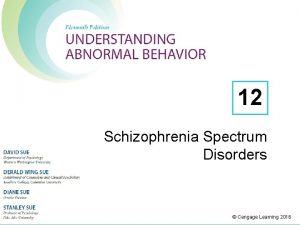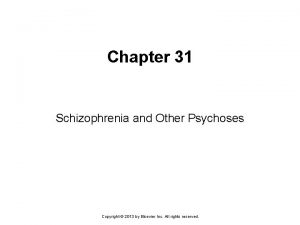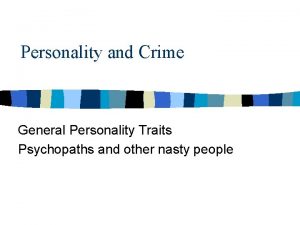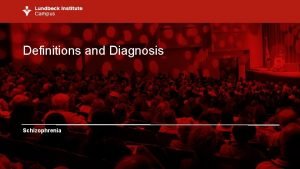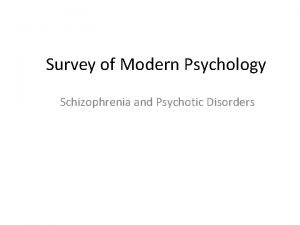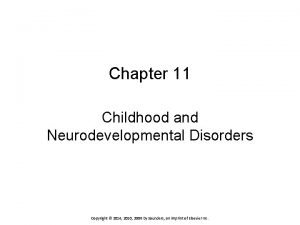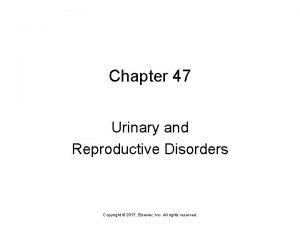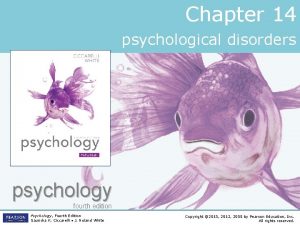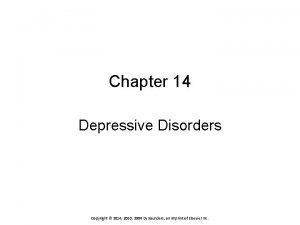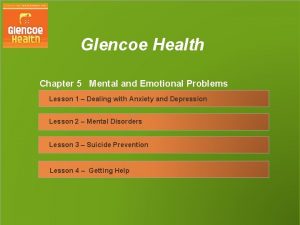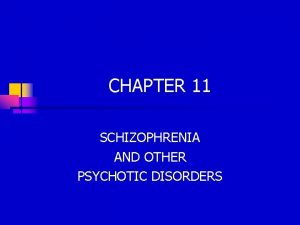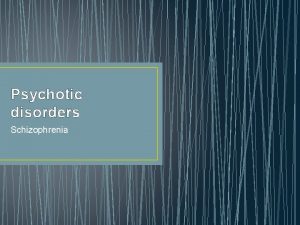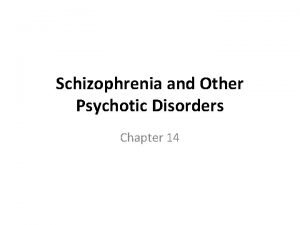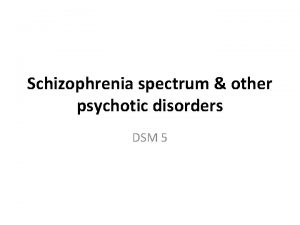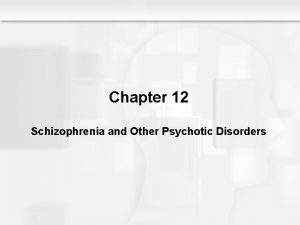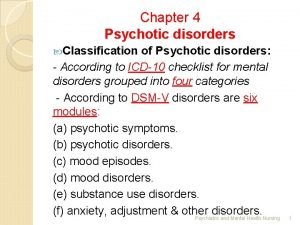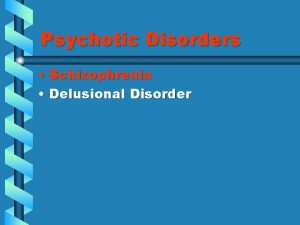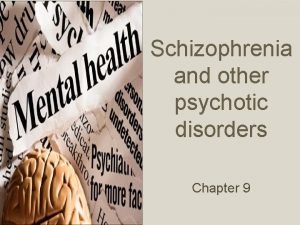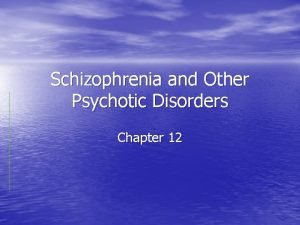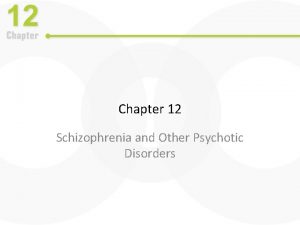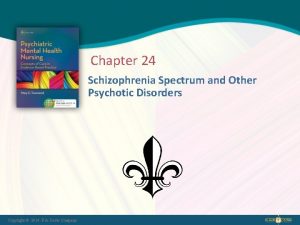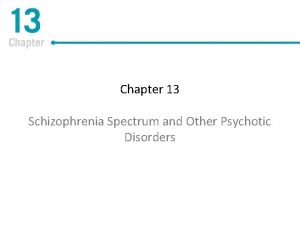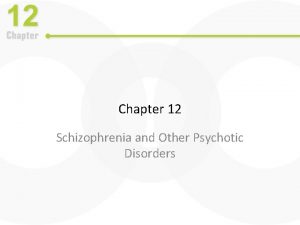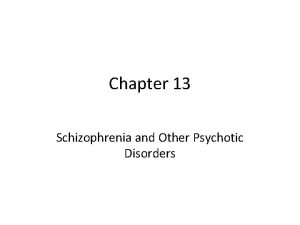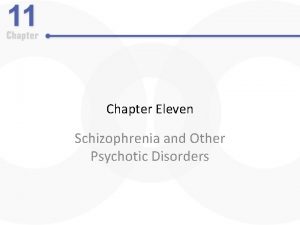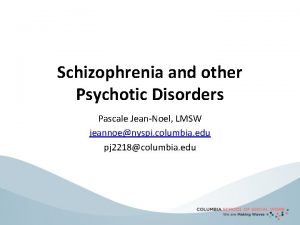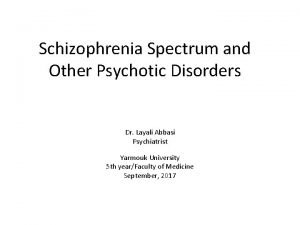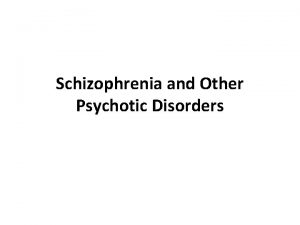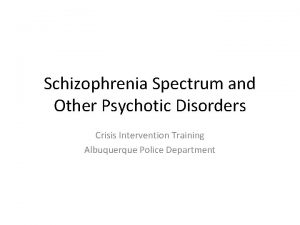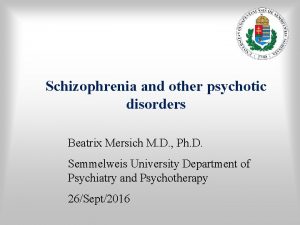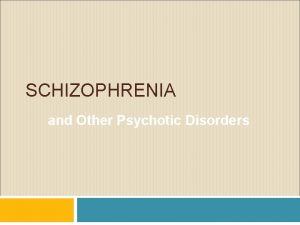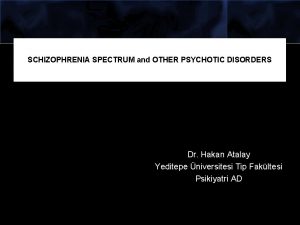Chapter 12 Schizophrenia and Other Psychotic Disorders Nature






































- Slides: 38

Chapter 12 Schizophrenia and Other Psychotic Disorders

Nature of Schizophrenia and Psychosis: An Overview • Schizophrenia vs. Psychosis – Psychotic behavior – Cluster of disorders characterized by hallucinations and/or loss of contact with reality – Schizophrenia – A type of psychosis with disturbed thought, perception, language, emotion, and behavior • Historical Background – Emil Kraeplin – Used the term dementia praecox, focused on onset and outcomes – Eugen Bleuler – Introduced the term “schizophrenia” or “splitting of the mind” • Impact of Early Ideas on Current Thinking About Schizophrenia – Many of Kraeplin and Bleuler’s ideas are still with us – Understanding onset and course are still considered important

Early figures in the history of schizophrenia Table 12. 1



Schizophrenia: The “Positive” Symptom Cluster • The Positive Symptoms – Active manifestations of abnormal behavior, distortions of normal behavior – Examples include delusions, hallucinations, and disorganized speech • Delusions: “The Basic Characteristics of Madness” – Gross misrepresentations of reality – Examples include delusions of grandeur or persecution • Hallucinations – Experience of sensory events without environmental input – Can involve all senses, but auditory hallucinations are the most common – Findings from SPECT studies

Some major language areas of the cerebral cortex Figure 12. 1

Schizophrenia: The “Negative” Symptom Cluster • The Negative Symptoms – Absence or insufficiency of normal behavior – Examples are emotional/social withdrawal, apathy, and poverty of thought/speech • Spectrum of Negative Symptoms – Avolition (or apathy) – Inability to initiate and persist in activities – Alogia – A relative absence of speech – Anhedonia – Inability to experience pleasure or engage in pleasurable activities – Flat affect – Show little expressed emotion, but may still feel emotion

Schizophrenia: The “Disorganized” Symptoms • The Disorganized Symptoms – Include severe and excess disruptions in speech, behavior, and emotion • Nature of Disorganized Speech – Cognitive slippage – Illogical and incoherent speech – Tangentiality – “Going off on a tangent” and not answering a question directly – Loose associations or derailment – Taking conversation in unrelated directions • Nature of Disorganized Affect – Inappropriate emotional behavior (e. g. , crying when one should be laughing) • Nature of Disorganized Behavior – Includes a variety of unusual behaviors – Catatonia – Spectrum from wild agitation, waxy flexibility, to complete immobility


Subtypes of Schizophrenia • Paranoid Type – 295. 30 – Intact cognitive skills and affect, and do not show disorganized behavior – Hallucinations and delusions center around a theme (grandeur or persecution) • Disorganized Type – 295. 10 – Marked disruptions in speech and behavior, flat or inappropriate affect – Hallucinations and delusions have a theme, but tend to be fragmented – This type develops early, tends to be chronic, lacks periods of remissions

Subtypes of Schizophrenia (cont. ) • Catatonic Type – 295. 20 – Show unusual motor responses and odd mannerisms (e. g. , echolalia, echopraxia) – This subtype tends to be severe and quite rare • Undifferentiated Type – 295. 90 – Major symptoms of schizophrenia, but fail to meet criteria for another type • Residual Type – 295. 60 – One past episode of schizophrenia – Continue to display less extreme residual symptoms (e. g. , odd beliefs)

Other Psychotic Disorders • Schizophreniform Disorder – 295. 40 – Schizophrenic symptoms for less than 6 months – Associated with good premorbid functioning; most resume normal lives • Schizoaffective Disorder – 295. 70 – Symptoms of schizophrenia and a mood disorder (e. g. , bipolar disorder) – Prognosis is similar for people with schizophrenia – Such persons do not tend to get better on their own • Delusional Disorder – 297. 1 – Delusions that are contrary to reality without other major schizophrenia symptoms – Many show other negative symptoms of schizophrenia – Type of delusions include erotomanic, grandiose, jealous, persecutory, and somatic – This condition is extremely rare

Additional Disorders with Psychotic Features • Brief Psychotic Disorder – 298. 8 – Experience one or more positive symptoms of schizophrenia – Usually precipitated by extreme stress or trauma – Lasts less than one month • Shared Psychotic Disorder – 297. 3 – Delusions from one person manifest in another person – Little is known about this condition • Schizotypal Personality Disorder - – May reflect a less severe form of schizophrenia

Classification Systems and Their Relation to Schizophrenia • • • Process vs. Reactive Distinction – Process – Insidious onset, biologically based, negative symptoms, poor prognosis – Reactive – Acute onset (extreme stress), notable behavioral activity, best prognosis Good vs. Poor Premorbid Functioning in Schizophrenia – Focus on person’s level of function prior to developing schizophrenia – No longer widely used Type I vs. Type II Distinction and Schizophrenia – Type I – Positive symptoms, good response to medication, optimistic prognosis, and absence of intellectual impairment – Type II – Negative symptoms, poor response to medication, pessimistic prognosis, and intellectual impairments

Schizophrenia: Some Facts and Statistics • Onset and Prevalence of Schizophrenia worldwide – About 0. 2% to 1. 5% (or about 1% population) – Usually develops in early adulthood, but can emerge at any time • Schizophrenia Is Generally Chronic – Most suffer with moderate-to-severe impairment throughout their lives – Life expectancy in persons with schizophrenia is slightly less than average • Schizophrenia Affects Males and Females About Equally – Females tend to have a better long-term prognosis – Onset of schizophrenia differs between males and females • Schizophrenia Appears to Have a Strong Genetic Component

Gender differences in onset of schizophrenia in a sample of 470 patients Figure 12. 2

Schizophrenia: Genetic Influences • Family Studies – Inherit a tendency for schizophrenia, not a specific form of schizophrenia – Schizophrenia in the family increases risk for schizophrenia in other family members • Twin Studies – Risk of schizophrenia in monozygotic twins is 48% – Risk of schizophrenia drops to 17% for fraternal (dizygotic) twins • Adoption Studies – Risk of schizophrenia remains high in adopted children with a biological parent suffering from schizophrenia

Schizophrenia: Genetic Influences (cont. ) • Summary of Genetic Research – Risk of schizophrenia increases as a function of genetic relatedness – One need not show symptoms of schizophrenia to pass on relevant genes – Schizophrenia has a strong genetic component, but genes alone are not enough

Risk of developing schizophrenia Figure 12. 4

Risk for schizophrenia among children of twins Figure 12. 5

Search for Behavioral and Genetic Markers of Schizophrenia • The Search for Behavioral Markers: Smooth-Pursuit Eye Movement – Tracking a moving object visually with the head kept still – Tracking is deficit in persons with schizophrenia, including their relatives • The Search for Genetic Markers: Linkage and Association Studies – Search for genetic markers is still inconclusive – Schizophrenia is likely involves multiple genes

Schizophrenia: Neurobiological Influences • Neurobiology and Neurochemistry: The Dopamine Hypothesis – Drugs that increase dopamine (agonists), result in schizophreniclike behavior – Drugs that decrease dopamine (antagonists), reduce schizophrenic -like behavior – Examples include neuroleptics and L-Dopa for Parkinson’s disease – The dopamine hypothesis proved problematic and overly simplistic – Current theories emphasize several neurotransmitters and their interaction

Some ways drugs affect neurotransmission Figure 12. 6

Schizophrenia: Other Neurobiological Influences • Structural and Functional Abnormalities in the Brain – Enlarged ventricles and reduced tissue volume – Hypofrontality – Less active frontal lobes (a major dopamine pathway) • Viral Infections During Early Prenatal Development – The relation between early viral exposure and schizophrenia is inconclusive • Conclusions About Neurobiology and Schizophrenia – Schizophrenia is associated with diffuse neurobiological dysregulation – Structural and functional abnormalities in the brain are not unique to schizophrenia

Location of the cerebrospinal fluid in the human brain Figure 12. 7

Schizophrenia: Psychological and Social Influences • The Role of Stress – May activate underlying vulnerability and/or increase risk of relapse • Family Interactions – Families of people with schizophrenia show ineffective communication patterns – High expressed emotion in the family is associated with relapse • The Role of Psychological Factors – Psychological factors likely exert only a minimal effect in producing schizophrenia

Cultural differences in expressed emotion (EE) Figure 12. 8


Medical Treatment of Schizophrenia • Historical Precursors • Antipsychotic (Neuroleptic) Medications – Medication is often the first line of treatment for schizophrenia – Began in the 1950 s – Most medications reduce or eliminate the positive symptoms of schizophrenia – Acute and permanent extrapyramidal and Parkinson-like side effects are common – Poor compliance with medication is common • Transcranial Magnetic Stimulation – Relatively untested procedure for treatment of hallucinations


Psychosocial Treatment of Schizophrenia • Historical Precursors • Psychosocial Approaches: Overview and Goals – Behavioral (i. e. , token economies) on inpatient units – Community care programs – Social and living skills training – Behavioral family therapy – Vocational rehabilitation • Psychosocial Approaches Are Usually a Necessary Part of Treatment


Summary of Schizophrenia and Psychotic Disorders • Schizophrenia Includes a Spectrum on Cognitive, Emotional, and Behavioral Dysfunctions – Positive, negative, and disorganized symptom clusters • DSM-IV and DSM-IV-TR Divides Schizophrenia Into Five Subtypes • Other DSM-IV and DSM-IV-TR Disorders Include Psychotic Features • Several Causative Factors Have Been Implicated for Schizophrenia • Successful Treatment Rarely Includes Complete Recovery

Summary of Schizophrenia and Psychotic Disorders (cont. ) Figure 13. x 1 Exploring schizophrenia and its treatment

Summary of Schizophrenia and Psychotic Disorders (cont. ) Figure 13. x 1 (cont. ) Exploring schizophrenia and its treatment

Summary of Schizophrenia and Psychotic Disorders (cont. ) Figure 13. x 2 Exploring symptoms and types of schizophrenia

Summary of Schizophrenia and Psychotic Disorders (cont. ) Figure 13. x 2 (cont. ) Exploring symptoms and types of schizophrenia
 Looseness of association
Looseness of association Chapter 12 schizophrenia spectrum disorders
Chapter 12 schizophrenia spectrum disorders Is schizophrenia on a spectrum
Is schizophrenia on a spectrum Chapter 31 schizophrenia and other psychoses
Chapter 31 schizophrenia and other psychoses Neurotic vs psychotic
Neurotic vs psychotic Traits of a psychopath
Traits of a psychopath Dsm 5 vs dsm 4
Dsm 5 vs dsm 4 Catatonia
Catatonia Bipolar and other related disorders
Bipolar and other related disorders Bipolar and other related disorders
Bipolar and other related disorders Nature and nature's law lay hid in night
Nature and nature's law lay hid in night Define a primary skin lesion and list three types
Define a primary skin lesion and list three types Chapter 6 musculoskeletal system diseases and disorders
Chapter 6 musculoskeletal system diseases and disorders Chapter 46 digestive and endocrine disorders
Chapter 46 digestive and endocrine disorders Somatic symptom disorder
Somatic symptom disorder Chapter 29 endocrine and metabolic disorders
Chapter 29 endocrine and metabolic disorders Chapter 21 mental health diseases and disorders
Chapter 21 mental health diseases and disorders Chapter 18 eating and feeding disorders
Chapter 18 eating and feeding disorders Chapter 17 reproductive system diseases and disorders
Chapter 17 reproductive system diseases and disorders Chapter 15 nervous system diseases and disorders
Chapter 15 nervous system diseases and disorders Chapter 15 anxiety and obsessive-compulsive disorders
Chapter 15 anxiety and obsessive-compulsive disorders Chapter 11 childhood and neurodevelopmental disorders
Chapter 11 childhood and neurodevelopmental disorders Chapter 8 skin disorders and diseases
Chapter 8 skin disorders and diseases Plicatured nail treatment
Plicatured nail treatment Nail diseases and disorders milady
Nail diseases and disorders milady Cardiovascular system diseases and disorders chapter 8
Cardiovascular system diseases and disorders chapter 8 Milady chapter 8 skin disorders and diseases
Milady chapter 8 skin disorders and diseases Chapter 47 urinary and reproductive disorders
Chapter 47 urinary and reproductive disorders Managing weight and eating behaviors
Managing weight and eating behaviors Chapter 10 lymphatic system diseases and disorders
Chapter 10 lymphatic system diseases and disorders Other initiated other repair
Other initiated other repair Determinace lidské psychiky
Determinace lidské psychiky Chapter 18 psychological disorders
Chapter 18 psychological disorders Chapter 11 genetic disorders concept mapping
Chapter 11 genetic disorders concept mapping Chapter 18 psychological disorders
Chapter 18 psychological disorders Chapter 14 psychological disorders
Chapter 14 psychological disorders Chapter 14 depressive disorders
Chapter 14 depressive disorders Chapter 5 mental and emotional problems
Chapter 5 mental and emotional problems Chapter 5 lesson 2 mental disorders
Chapter 5 lesson 2 mental disorders
